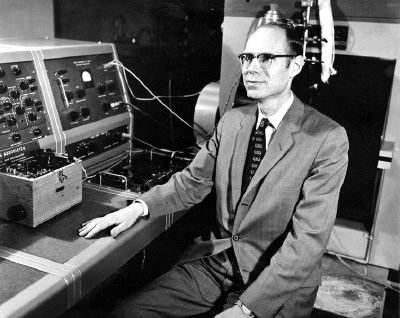 Everyone [sic] probably has the story tucked away in their head that science fiction author Arthur C. Clarke was the father of the communications satellite. I only recently realized, though, that satellites have, if not a thousand, then at least two fathers.
Everyone [sic] probably has the story tucked away in their head that science fiction author Arthur C. Clarke was the father of the communications satellite. I only recently realized, though, that satellites have, if not a thousand, then at least two fathers.
Dr. John R. Pierce was Executive Director of Bell Labs' Research Communications Principles Division. He coined the word "transistor." And in 1955, independent of Clarke's 1945 conception of manned, geostationary satellites, Pierce published a proposal for an unmanned communications satellite.
"Orbital Radio Relays" was published in April 1955 in Jet Propulsion, by the American Rocket Society. Pierce calculated that relays in space would be useful for transoceanic communication and proposed three types:
(a) 100-foot reflecting spheres at an altitude of around 2,200 miles; (b) a 100-foot oriented plane mirror in a 24-hour orbit, at an altitude of 22,000 miles; (c) an active repeater in a 24-hour orbit.He was concerned with maintaining proper orientation in cases (b) and (c), the geostationary orbits, and so concluded that (a), a 100-foot inflatable sphere, was the easiest, most feasible starting point.
So yes, Pierce's proposal triggered NASA's early work on Project Echo, and NASA teamed with Pierce's Bell Labs to operate it. Meanwhile, by 1960, Pierce was already well along on developing the first commercial satellite, Telstar I, which launched in 1962.
I'm kind of blown away by how much major work Pierce was involved in, but also at the breadth of his contributions and interest. And yet I'd basically never heard of him [or, rather, made the connection.] He wrote regularly for a non-expert audience on the role of technology in art, music, and literature. His 1968 collected essays is titled, Science, Art, and Communication.
But he was no technological evangelist, no Marshall McLuhan-style pop guru. And certainly not even remotely avant-garde. As far as I can tell, there were no Billy Kluver-style artist collabos for John Pierce.
Pierce opened a speech about Echo I at the Economic Club of Chicago on Dec. 8, 1960 by quoting Milton:
Sweet Echo, Sweetest nymph--So even as he zeroed in on the cost and technical calcuations needed to realize them, Pierce had to have been conscious of the beauty, the aesthetic perfection, even, of the satelloons he conceived.
Sweet Queen of Parley, Daughter of the Sphere!
So may'st thou be translated to the skies
And give resounding grace to all Heaven's harmonies!
A few weeks ago, I stumbled across an insane collection of photo negatives relating to Project Echo, including this image, of Pierce at the Palmer House hotel for the Economic Club dinner, prepping a fully functioning demo how Echo I works. Fully functioning. They are not miming; there are actual vacuum tubes and whatnot underneath that transmitter dish and the horn antenna. And of course, there's a chandelier-sized satelloon hanging from the ceiling. Dr. John R. Pierce is now my favorite performance artist, and I must collect the ephemera from his most important work.













